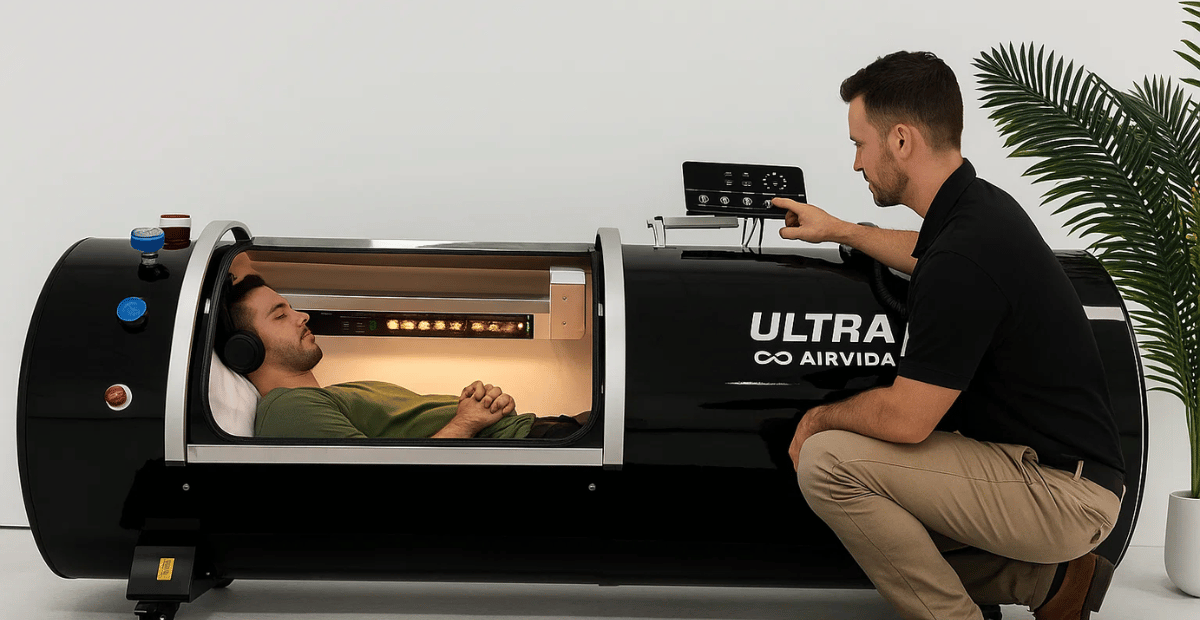When people first hear about hyperbaric oxygen therapy (HBOT), a common question that arises is, “Does HBOT turn your blood into oxygen?” The idea sounds almost futuristic, breathing pure oxygen in a pressurized chamber to help the body heal or recover faster. While the science behind HBOT is grounded in how oxygen behaves under pressure, the reality is a bit more nuanced than simply “turning blood into oxygen.”
In this article, you’ll learn what happens to your blood during HBOT, how oxygen interacts with red blood cells, and what current studies suggest about its possible benefits. It also highlights safe use practices and why consulting a qualified medical professional is always essential before starting HBOT.
What Actually Happens to Your Blood During HBOT
To answer the question, does HBOT turn your blood into oxygen? The short response is not exactly. Your blood doesn’t become oxygen; rather, HBOT increases the amount of oxygen your blood can carry. During an HBOT session, you breathe pure oxygen inside a sealed, pressurized chamber. The pressure helps dissolve more oxygen into your plasma, the liquid component of your blood, than what’s possible under normal atmospheric conditions.
This higher level of oxygen in the plasma may help more oxygen reach body tissues, especially areas with limited blood flow. It’s this increased oxygen availability that might support cell metabolism, recovery, and repair. However, it’s crucial to understand that HBOT is not a cure-all and results vary depending on individual health status. Always discuss HBOT with a qualified healthcare provider before starting any therapy.
Related article: Hyperbaric Chamber and Multiple Sclerosis: Potential Benefits
The Science Behind Oxygen Absorption

The science that helps explain does HBOT turn your blood into oxygen? Is rooted in Henry’s Law, which states that gas solubility increases when pressure rises. In the context of HBOT, the elevated pressure allows more oxygen to dissolve directly into the plasma, supplementing what red blood cells already carry.
When oxygen levels in the plasma rise, several potential effects may occur:
-
Improved oxygen delivery to tissues that are injured, inflamed, or have limited circulation
-
Support for cellular energy production, which might help cells function more efficiently
-
A more favorable environment for tissue recovery and repair processes
-
Possible reduction in localized inflammation through better oxygenation
-
Enhanced overall wellness potential, depending on individual response and frequency of use
Still, scientific research is ongoing, and many findings highlight potential rather than proven outcomes. Because responses differ from person to person, medical oversight remains essential to ensure the safe and appropriate use of HBOT. For those exploring mild hyperbaric options, browsing the mHBOT chamber collection may offer helpful insights into available wellness-focused systems designed for home or clinic use.
Does HBOT Turn Your Blood Into Oxygen? The Real Answer
Revisiting the main question: Does HBOT turn your blood into oxygen? The scientific reality is that HBOT enhances oxygen delivery rather than transforming the composition of blood itself. Red blood cells continue to perform their role of transporting oxygen throughout the body, while the increased pressure allows additional oxygen to dissolve into plasma.
This combination might temporarily raise the total oxygen available to cells, possibly aiding healing and recovery processes. However, HBOT doesn’t alter your blood’s structure or replace red blood cells with oxygen molecules. It simply improves how efficiently oxygen moves within your circulatory system. Understanding this difference is key to appreciating what HBOT may do without overstating its effects.
Potential Benefits of Increased Oxygen Levels
When discussing, does HBOT turn your blood into oxygen? It’s helpful to consider the possible outcomes of enhanced oxygenation. Research suggests that higher oxygen levels may, especially when using safe, lower-pressure systems like those found in the 1.3 ATA hyperbaric chamber collection, contribute to improved wellness and recovery support through better cellular oxygen utilization.
-
Support recovery from fatigue or exercise-related strain
-
Aid in wound care or post-surgery tissue repair
-
Reduce temporary inflammation
-
Promote overall circulation efficiency.
These potential benefits are part of why HBOT has gained attention in both clinical and wellness settings. Yet, the therapy’s effectiveness can vary greatly depending on individual health conditions, frequency of sessions, and adherence to professional supervision. HBOT should never replace medical treatment prescribed by a healthcare professional. It’s best used as a complementary approach under proper medical advice.
Safety, Guidelines, and Who Should Avoid HBOT
Because the effects of pressurized oxygen are powerful, safety remains a top priority. Individuals considering HBOT should undergo a medical evaluation first. While generally well-tolerated, the therapy might cause mild side effects such as ear pressure, sinus discomfort, or temporary fatigue.
For those exploring reliable systems, the Hyperbaric Chamber NYC collection offers professionally designed options that emphasize safety and comfort. More serious complications are rare but can occur if sessions are not properly managed.
Conditions and Considerations Before Undergoing HBOT:
-
Respiratory infections: Active infections may interfere with breathing comfort and increase pressure-related risks.
-
Uncontrolled fever: Elevated body temperature can affect how the body responds to oxygen under pressure.
-
Untreated pneumothorax: This condition must be medically cleared, as pressure changes could worsen symptoms.
-
Ear or sinus problems: Individuals with chronic sinus issues or middle ear dysfunction may need specialized guidance.
Whether you’re exploring HBOT for wellness or recovery, always consult a licensed medical professional to ensure it’s appropriate for your health needs and performed under safe conditions.
Related article: Importance of Hyperbaric Chamber Training for Medical Staff
Explore Home Hyperbaric Chambers by Airvida

For individuals asking “Does HBOT turn your blood into oxygen?” and interested in experiencing the therapy conveniently, Airvida Chambers offers a range of high-quality, home-ready systems designed for comfort, reliability, and safety.
Their chambers are built with advanced air purification, cooling, and safety valves that support ease of use and peace of mind. Each model is designed to make HBOT accessible without constant clinical visits, allowing for consistent and monitored use from the comfort of home.
If you’d like to explore available models and specifications, visit the collection here:
Explore Airvida’s Hyperbaric Chamber Collection
Remember, even for home systems, consulting a healthcare professional before beginning HBOT remains vital to ensure safe and beneficial use.
Does HBOT Turn Your Blood Into Oxygen? Final Thoughts and Key Takeaways
Understanding how hyperbaric oxygen therapy works helps clarify many of the misconceptions surrounding it. By learning the basics of oxygen absorption and how pressure affects circulation, readers can better appreciate the possible wellness applications of HBOT without overestimating its capabilities. It’s a therapy that emphasizes balance, combining science, safety, and professional guidance.
Does HBOT turn your blood into oxygen? Not exactly, but it may increase how efficiently your body uses oxygen to promote healing and support recovery. This potential improvement in oxygen delivery could make a difference in your overall wellness routine. To explore high-quality, home-ready chambers and learn more about safe and effective HBOT options, contact Airvida Chambers for personalized guidance and product information today.
Frequently Asked Questions
Does a hyperbaric chamber increase oxygen?
Yes, a hyperbaric chamber may increase oxygen levels in your body by allowing more oxygen to dissolve into your blood plasma under pressure. This can potentially enhance oxygen delivery to tissues, but effects vary, and medical supervision is always recommended.
What is the oxygen level in an HBOT?
During HBOT sessions, oxygen levels typically range from 95% to 100% inside the chamber. The increased atmospheric pressure helps your body absorb more oxygen than normal air exposure, though exact levels depend on the chamber type and protocol used.
Is hyperbaric oxygen therapy safe during pregnancy?
HBOT during pregnancy should only be performed under strict medical supervision. While it’s sometimes used in emergencies like carbon monoxide poisoning, routine or wellness use may not be recommended. Pregnant individuals should always consult their healthcare provider before considering HBOT.
Does HBOT increase blood flow?
HBOT may help improve blood flow by increasing oxygen dissolved in plasma, which might support circulation in low-oxygen areas. However, responses vary among individuals, and anyone with circulatory or heart conditions should seek medical advice before starting hyperbaric therapy.
Is hyperbaric oxygen therapy 100% oxygen?
Yes, most HBOT systems use nearly 100% pure medical-grade oxygen. The therapy involves breathing this oxygen inside a pressurized chamber, which may enhance absorption into the bloodstream. Safe operation and medical approval are crucial for avoiding complications or excessive exposure.
You May Also Want to Read
Best Hyperbaric Chamber in Fort Lauderdale for Your Needs
Best Hyperbaric Chamber in Springfield, MO: Safe Healing Therapy
Should You Sauna or Cold Plunge First? Expert Wellness Guide




